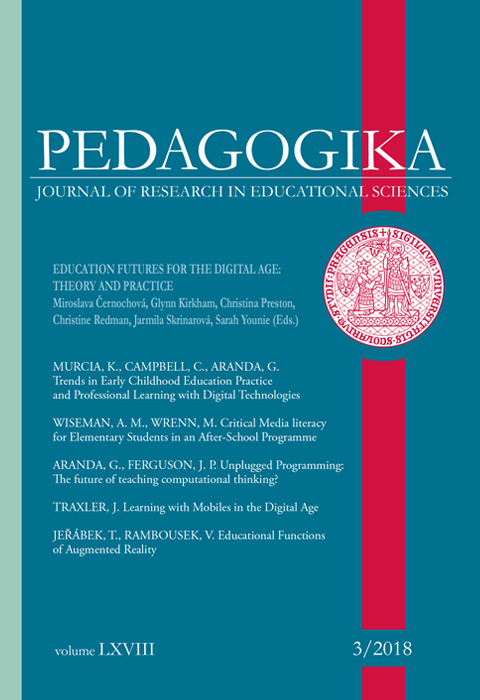Critical Media Literacy for Elementary Students in an After-School Programme
DOI:
https://doi.org/10.14712/23362189.2018.838Klíčová slova:
critical media literacy, elementary students, qualitative researchAbstrakt
As students’ uses and experiences with literacy are changing due to technological innovations, particularly in their out-of-school contexts, it is important to consider how media literacy is a social practice, particularly one where students are engaging socially, culturally, and politically. This is particularly relevant to the way that messages are conveyed through popular media such as commercials, video games, and television programmes. Th e purpose of this paper is to explore what happens when students use a critical media literacy to respond to mass media texts and images. The primary question this research attempts to answer is: What happens when students use a critical media literacy approach to discuss and interpret print and visual media images in an after-school setting? We used qualitative research methods to collect data and thematic analysis to analyse data. Findings reflect how students discussed identity, bullying and aggression, socioeconomic status, materialism and consumerism.
Reference
Bazalgette, C., & Buckingham, D. (2013). Literacy, media and multimodality: a critical response. Literacy, 47(2), 95-102.
https://doi.org/10.1111/j.1741-4369.2012.00666.x
Bazalgette, C., Parry, B., & Potter, J. (2011). Creative, cultural and critical: Media literacy theory in the primary classroom. In Creative Engagements: Thinking with Children 7th Global Conference. Oxford, UK. Available at http://eprints.whiterose.ac.uk
Creswell, J. W., & Poth, C. N (2018). Qualitative inquiry and research design: Choosing among five approaches (4th edition). Los Angeles, CA: Sage.
Curtis, C. P. (1995). Watsons go to Birmingham. New York: Random House.
Flores-Koulish, S. A., & Smith-D'Arezzo, W. M. (2016). "The Three Pigs": Can they blow us into critical media literacy old school style? Journal of Research in Childhood Education, 30(3), 349-360.
https://doi.org/10.1080/02568543.2016.1178673
Funk, S., Kellner, D., & Share, J. (2015). Critical media literacy as transformative pedagogy. In M. N. Yildiz & J. Keengwe (Eds.), Handbook of research on media literacy in the digital age (Chapter 1). Hersley, PA: IGI Global.
Gainer, J. S. (2010). Critical media literacy in middle school: Exploring the politics of representation. Journal of Adolescent and Adult Literacy, 53(5), 364-373.
https://doi.org/10.1598/JAAL.53.5.2
Kellner, D., & Share, J. (2007). Critical media literacy is not an option. Learning Inquiry, 1(1), 59-69.
https://doi.org/10.1007/s11519-007-0004-2
Kelly, C., & Brower, C. (2017). Making meaning through media: Scaffolding academic and critical media literacy with texts about schooling. Journal of Adolescent and Adult Literacy, 60(6), 655-666.
https://doi.org/10.1002/jaal.614
Kessler, T., Tinio, P. L., & Nolan, B. T. (2016). What's our position? A critical media literacy study of popular culture websites with Eighth-grade special education students. Reading & Writing Quarterly, 32(1), 1-26.
https://doi.org/10.1080/10573569.2013.857976
Kuklin, S. (2006). Families. New York: Hyperion.
PMCid:PMC1418914
Lee, R. (Director). (2011). 21st century girl [Recorded by Willow Smith]. Roc Nation, LLC [video]. Available at http://www.youtube.com
Levin, D. (2010). Remote control childhood: Combating the hazards of media culture in schools. New Horizons in Education, 58(3), 14-25.
Livingstone, S., Papaioannou, T., Pérez, M. M. G., & Wijnen, C. W. (2012). Critical insights in European media literacy research and policy. Media Studies, 3(6), 2-12.
Livingstone, S., Haddon, L., Görzig, A., & Ólafsson, K. (2011). Risks and safety on the Internet: The perspective of European children. London: LSE, EU Kids Online. Available at http://eprints.lse.ac.uk
Marsh, J. (2014). Purposes for literacy in children's use of the online virtual world Club Penguin. Journal of Research in Reading, 37(2), 179-195.
https://doi.org/10.1111/j.1467-9817.2012.01530.x
Marsh, J., & Bishop, J. (2014). We're playing Jeremy Kyle! Television talk shows in the playground. Discourse: Studies in the Cultural Politics of Education, 35(1), 16-30.
https://doi.org/10.1080/01596306.2012.739464
Medina, C. L., & Costa, M. del R. (2013). Latino media and critical pedagogies. Journal of Language & Literacy Education, 9(1), 161-184. Available at http://jolle.coe.uga.edu
Merriam, S. B. (2009). Qualitative research: A guide to design and implementation. San Francisco, CA: Jossey-Bass.
Moje, E. B. (2009). Standpoints: A call for new research on new and multi-literacies. Research in the Teaching of English, 43(4), 348-362.
Puchner, L., Markowitz, L., & Hedley, M. (2015). Critical media literacy and gender: Teaching middle school students about gender stereotypes and occupations. Journal of Media Literacy Education, 7(2), 23-34. Available at https://digitalcommons.uri.edu
Semali, L. (2003). Ways with visual languages: Making the case for critical media literacy. The Clearing House, 76(6), 271-277.
https://doi.org/10.1080/00098650309602018
Silverblatt, A., Miller, D. C., Smith, J., & Brown, N. (2014). Media literacy: Keys to interpreting media messages (4th ed.). ABC-CLIO, LLC.
Tobin, J. (2000). "Good guys don't wear hats": Children's talk about the media. New York: Columbia University, Teachers College Press.
Tracy, S. J. (2010). Qualitative quality: Eight a "big-tent" criteria for excellent qualitative research. Qualitative Inquiry, 16(10), 837-851.
https://doi.org/10.1177/1077800410383121
Walsh, M. (2008). Worlds have collided and modes have merged: Classroom evidence of changed literacy practices. Literacy, 42(2), 101-108.
https://doi.org/10.1111/j.1741-4369.2008.00495.x
Wiseman, A. M., Kupiainen, R., & Makinen, M. (2017). Talking back and redesigning texts: Critical media literacy for elementary students in an afterschool program. In M. Bock, A. Hudelist, & F. Auernig (Eds.), Literacy in the new landscape of communication: Research, education and the everyday (p. 49-56). Graz, Austria: Austrian Literacy Association.
PMid:29150562 PMCid:PMC5736429



